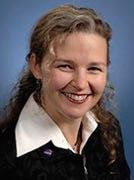
Please Note: The content on this page is not maintained after the colloquium event is completed. As such, some links may no longer be functional.
Christa Peters-Lidard
A mission Simulation and Evaluation Platform for Terrestrial Hydrology Using the NASA Land Information System (LIS)
Wednesday, February 18, 2015
Building 3 Auditorium - 11:30 AM
(Coffee and cookies at 10:30 AM)
Observing System Simulation Experiments (OSSEs) are often conducted to evaluate the worth of existing data and data yet to be collected from proposed new missions. As missions increasingly require a broader "Earth systems" focus, it is important that the OSSEs capture the potential benefits of the observations on end-use applications. Towards this end, the results from the OSSEs must also be evaluated with a suite of metrics that capture the value, uncertainty, and information content of the observations while factoring in both science and societal impacts. In this presentation, we present the development of an end-to-end and end-use application oriented OSSE platform using the capabilities of the NASA Land Information System (LIS) developed for terrestrial hydrology. Four case studies that demonstrate the capabilities of the system will be presented: (1) A soil moisture OSSE that employs simulated L-band measurements and examines their impacts towards applications such as floods and droughts. The experiment also uses a decision-theory based analysis to assess the economic utility of observations towards improving drought and flood risk estimates, (2) A GPM-relevant study quantifies the impact of improved precipitation retrievals from GPM towards improving landslide forecasts, (3) A case study that examines the utility of passive microwave soil moisture observations towards weather prediction, and (4) OSSEs used for developing science requirements for the GRACE-2 mission. These experiments also demonstrate the value of a comprehensive modeling environment such as LIS for conducting end-to-end OSSEs by linking satellite observations, physical models, data assimilation algorithms and end-use application models in a single integrated framework. For more information see http://lis.gsfc.nasa.gov
Dr. Christa D. Peters-Lidard is currently the Deputy Director for Hydrospheric and Biospheric Sciences in the Earth Sciences Division at NASA's Goddard Space Flight Center. She was a Physical Scientist in the Hydrological Sciences Laboratory from 2001-2015, and Lab Chief from 2005-2012. She graduated summa cum laude with a B.S. in Geophysics and a minor in Mathematics from Virginia Polytechnic Institute and State University (Virginia Tech) in 1991. She then went on to earn her M.A. and Ph.D. from the Water Resources Program in the Department of Civil Engineering and Operations Research at Princeton University in 1993 and 1997, respectively. Dr. Peters-Lidard was an Assistant Professor in the School of Civil and Environmental Engineering at Georgia Institute of Technology from 1997 to 2001. She is currently the Chief Editor for the American Meteorological Society (AMS) Journal of Hydrometeorology, and an elected member of the AMS Council. She has also served as an Associate Editor for the Journal of Hydrology and Water Resources Research. Her research interests include land-atmosphere interactions, soil moisture measurement and modeling, and the application of high performance computing and communications technologies in Earth system modeling, for which her Land Information System team was awarded the 2005 NASA Software of the Year Award. She is a member of Phi Beta Kappa, and was awarded the Committee on Space Research (COSPAR) Scientific Commission A Zeldovich Medal in 2004 and the Arthur S. Flemming Award in 2007. She was elected as an AMS Fellow in 2012.
IS&T Colloquium Committee Host: Karen Moe
Sign language interpreter upon request: 301-286-7040
